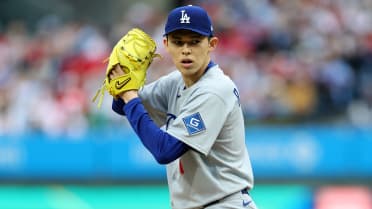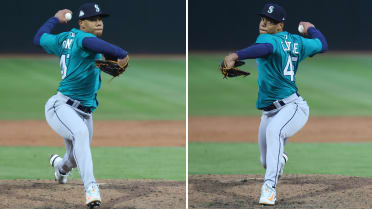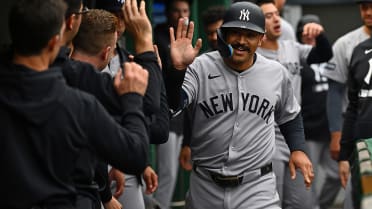It took exactly one pitch into the Rays' 2018 season for Kevin Kiermaier to make a fantastic defensive play, which is impressive even by his lofty standards. For all the praise we heap onto Byron Buxton, Kiermaier still has a pretty strong case to make to be considered the best defensive outfielder in baseball.
When Kiermaier ran across what seemed like half of Florida -- he started 129 feet away from the ball's projected landing point, and he actually covered 132 feet, which is a pretty good route -- in 6.6 seconds to rob Mookie Betts, he didn't just serve notice that he's still a stud in the field. By making his fantastic grab at the Tropicana Field wall so early in the game, he also helped us show off the latest update to Catch Probability before we'd even really announced it.
When we introduced Catch Probability last season, we touted it as a Statcast™ outfield range metric based on distance, time and direction, which could tell us how often similar opportunities were made. We also noted that "it doesn't yet account for the extra difficulty of catches at or over the wall, which is planned for 2018." It was a good start, but we knew improvement was necessary.
Well, it is 2018 now, so let's carry through on that promise: Catch Probability has now been updated to account for the difficulty of the wall. This makes the data on Kiermaier's play -- and those like it -- even more impressive. Instead of it being a 49 percent Catch Probability, as it would have been last year, it's now considered a six percent Catch Probability, making it one of the most difficult plays a fielder can make. When presented with similar opportunities since 2015, other outfielders have been unable to make that play more than 90 percent of the time.
As you can imagine, this is going to make for a lot of fun highlights of outfielders smashing into walls. Remember when Christian Yelich slammed face-first into the fence in Seattle last year? He earned more than just a busted lip; he gained a measure of revenge on batter Jarrod Dyson, who had robbed Yelich in similar fashion in 2016.
At the time, the Statcast™ metrics looked at it as a good play, giving it a 46 percent Catch Probability based on the distance, time and direction of the opportunity presented to Yelich. That's a "Four Star Play," out of five, which is good; that's saying that the play is made slightly less than half the time.
Now, it's an elite five percent play, meaning outfielders just about never get there. (It's not "zero percent," because sometimes they do; check out this similar Jake Marisnick play from 2016.)
It's a lot more satisfying to say that a play like that is almost never made, rather than say it is made half the time.
How it works
Consider this a two-step process. First, "wall balls" are considered to be any ball that was projected to land within eight feet of the wall (outfield walls only, not side walls) and no more than eight feet high on the wall, so as to not penalize players in Boston staring at a double clanging off the Green Monster 25 feet off the ground.
Second, all wall balls are compared only to themselves, rather than to all plays. This has the side effect of removing these plays from the larger non-wall sample.
What that does is to take a play that was already considered to be very good and help give it the credit it deserves. When Kevin Pillar ran 110 feet to rob Ruben Tejada and slam into the fence last year, it was given a 41 percent Catch Probability, his third-best catch of the year. Now, it's a two percent catch, one of the best from anyone all year.
While these are some extreme examples, as it turns out, there are relatively few of these plays. We tracked nearly 33,000 catches in 2017, and just under 2,000 -- or approximately six percent -- counted as "wall balls." Of those, only 64 (.001 percent) moved the needle by 40 points of Catch Probability. That's enough to want to account for them, but still only a small fraction of overall outfield plays.
They do, however, make for fun viewing. Giancarlo Stanton's late-season run of 96 feet in 5.4 seconds into the wall in Colorado gave him a 55 percent Catch Probability at the time. Now it's 11 percent. He does not, however, get extra credit for managing to not squish Yelich along the way.
As another example, Jackie Bradley Jr.'s robbery of Yunel Escobar last summer, will go from 69 percent to 24 percent, making it one of his best catches of the year.
Unsurprisingly, Bradley was one of two Boston fielders in the top five of wall-ball catches made in 2017. Sure, it's about skill, as you can see by the name at the top, but it's also about opportunity and the ballpark you call home.
2017 Wall Ball Catch Leaders
- Lorenzo Cain, 24
- Bradley Jr., 21
- Buxton, 20
- Andrew Benintendi, 19
- Marcell Ozuna, 18
This update will work very nicely for plays where a fielder is running at high speed into the wall, as in the examples you've seen. For plays where it's less about range than timing -- like when Bradley robbed Aaron Judgeof a home run by getting to a point, stopping and jumping -- the impact will be far less.
Seasonal impact
Because Catch Probability fuels our season-long outfield range metric, Outs Above Average, changes to individual plays will have some slight effects on the leaderboards, as well.
As you'd expect, Buxton does well here, gaining +4 outs, pushing him from +25 OAA, which was already the best in baseball, to +29. That's in part thanks to plays like this robbery of Carlos Santana, which drops from 52 percent to just seven percent under the new methodology.
Seven others, including Judge, Cain, Billy Hamilton and Ender Inciarte gain +3 OAA. Andrew McCutchen loses 3 OAA, dropping from 0 to -3. An overwhelming majority of players either didn't move at all, or did by only an out or two.
As we said above, there really aren't that many of these types of plays, all things considered. The ones that do exist really stand out, however, making all the best highlight reels. Now, Statcast™ will appropriately credit them from a metric perspective, as well.
Mike Petriello is an analyst for MLB.com and the host of the Statcast podcast.



